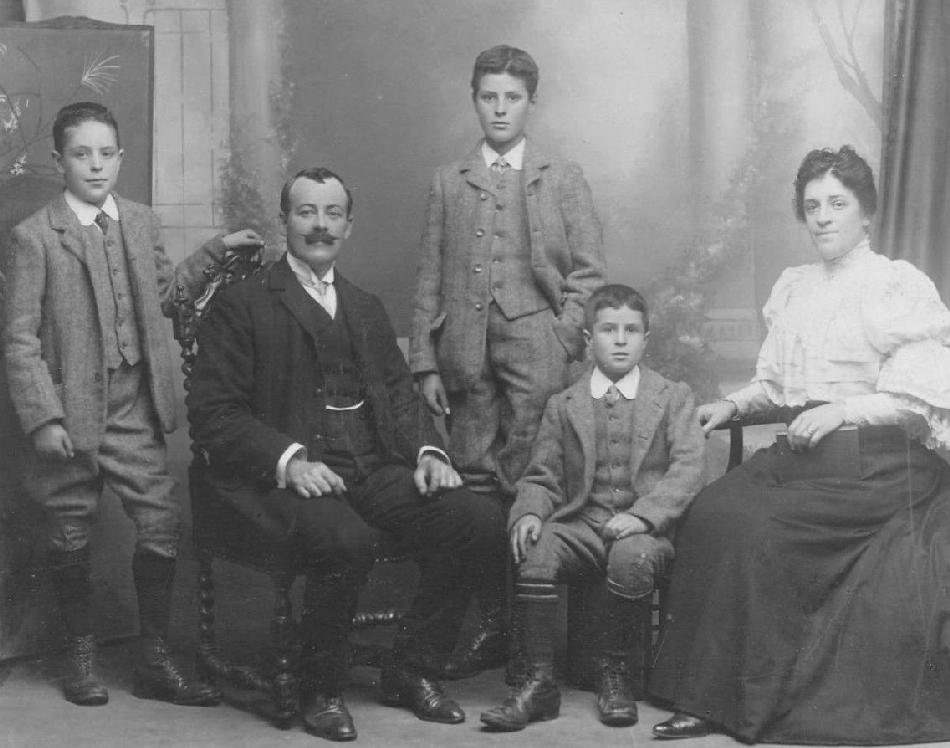
Glasgow Family (turn-of-the 20th century)

Figure 1.-- This cabinet card portrait shows an unidentified Glasgow family with three sons. The boys look to be about 9-15 years old. They wear identical matching single breasted vested knickers suits. The material looks like tweed. Their white collars are not the classic, pointed Eton collars which were widely worn at the time. The seem to have rounded tips. They do seem to be etachable collars. The boys seem to be wearing knee socks rather than long stockings with their knickers. In America boys for the most part were wearing long stockings. We thought at first that they may be wearing school uniforms. The banded knee socks came to be called school socks. We suspect that their parents simply decided to purchase identical outfits for the boys. The studio was Geo. Stewart in Glasgow.
|
|
This cabinet card portrait shows an unidentified Glasgow family with three sons. The boys look to be about 9-15 years old. They wear identical matching single breasted vested knickers suits. The material looks like tweed. Their white collars are not the classic, pointed Eton collars which were widely worn at the time. The seem to have rounded tips. They do seem to be etachable collars. The boys seem to be wearing knee socks rather than long stockings with their knickers. In America boys for the most part were wearing long stockings. We thought at first that they may be wearing school uniforms. The banded knee socks came to be called school socks. We suspect that their parents simply decided to purchase identical outfits for the boys. One factor here is that given their ages, the boys probably would have not attended the same school. And there small differences in the ties and socks which hint that the outfits are not school uniform. Although in Scotland there were accademies which dealt with wider age ranges than the private schools in England. In England they were called colleges, but there were not very many. (Do not confuse this with the American usage of a tertiary educational institution.) We are not sure how to date the portrait. The mother's blouse looks like a 1890s style with the baloon sleeves. The cabinet card mount looks to us like the 1900s decade. (Here we are going on the color, a kind of green grey. Unfortunatly because of our small Scottish archive we are going more on our knowledge of American mount trends. We may revise out date assessment as our Scottish archive grows. We think that we can safely say that it is a turn-of-the century image. Wether it falls on the 1890s or 1900s side we are not yet positive. A reader expresses surprise that the boys are not wearing kilts. It should be remembered that Glasgow was an industrial city is set in the Lowlands where kilts were much less common than in the Highlands.
HBC

Navigate the Boys' Historical Clothing Web Site:
[Return to the Main Scottish family page]
[About Us]
[Introduction]
[Activities]
[Biographies]
[Chronology]
[Clothing styles]
[Countries]
[Girls]
[Bibliographies]
[Contributions]
[FAQs]
[Glossaries]
[Images]
[Links]
[Registration]
[Tools]
[Boys' Clothing Home]
Navigate the Boys' Historical Clothing kilt pages:
[Main kilt page]
[Kilt suits]
[Scottish kilts]
[Scottish boys clothing]
[Scottish school uniform]
[Highland dance]
[Pipeband]
[Irish kilts]
[Irish boys clothing]
[Irish step dancing]
[Greek kilts]
Created: 4:09 AM 6/20/2016
Last updated: 6:32 PM 6/20/2016



